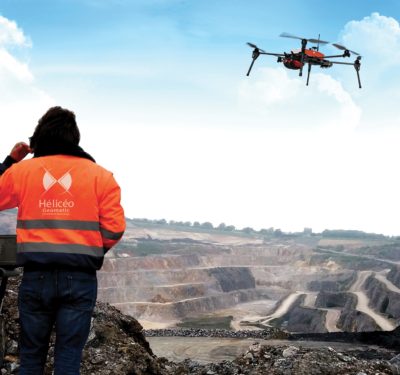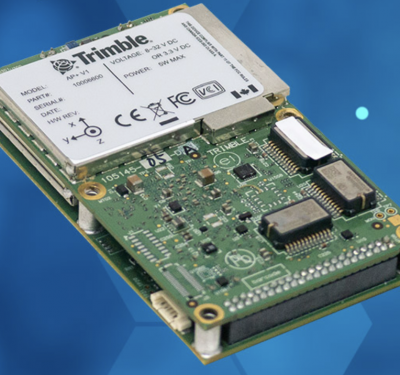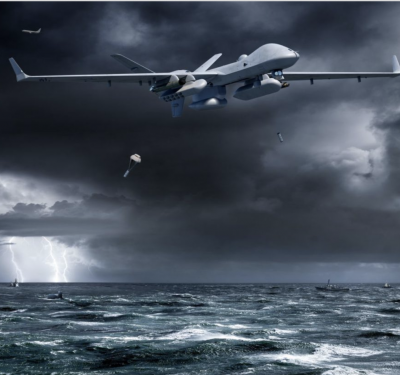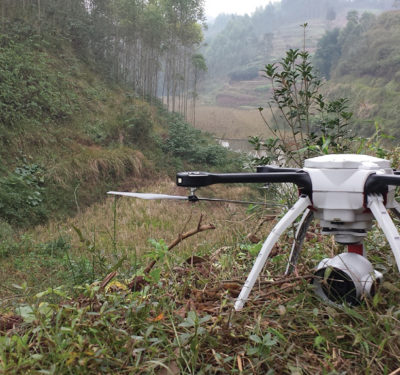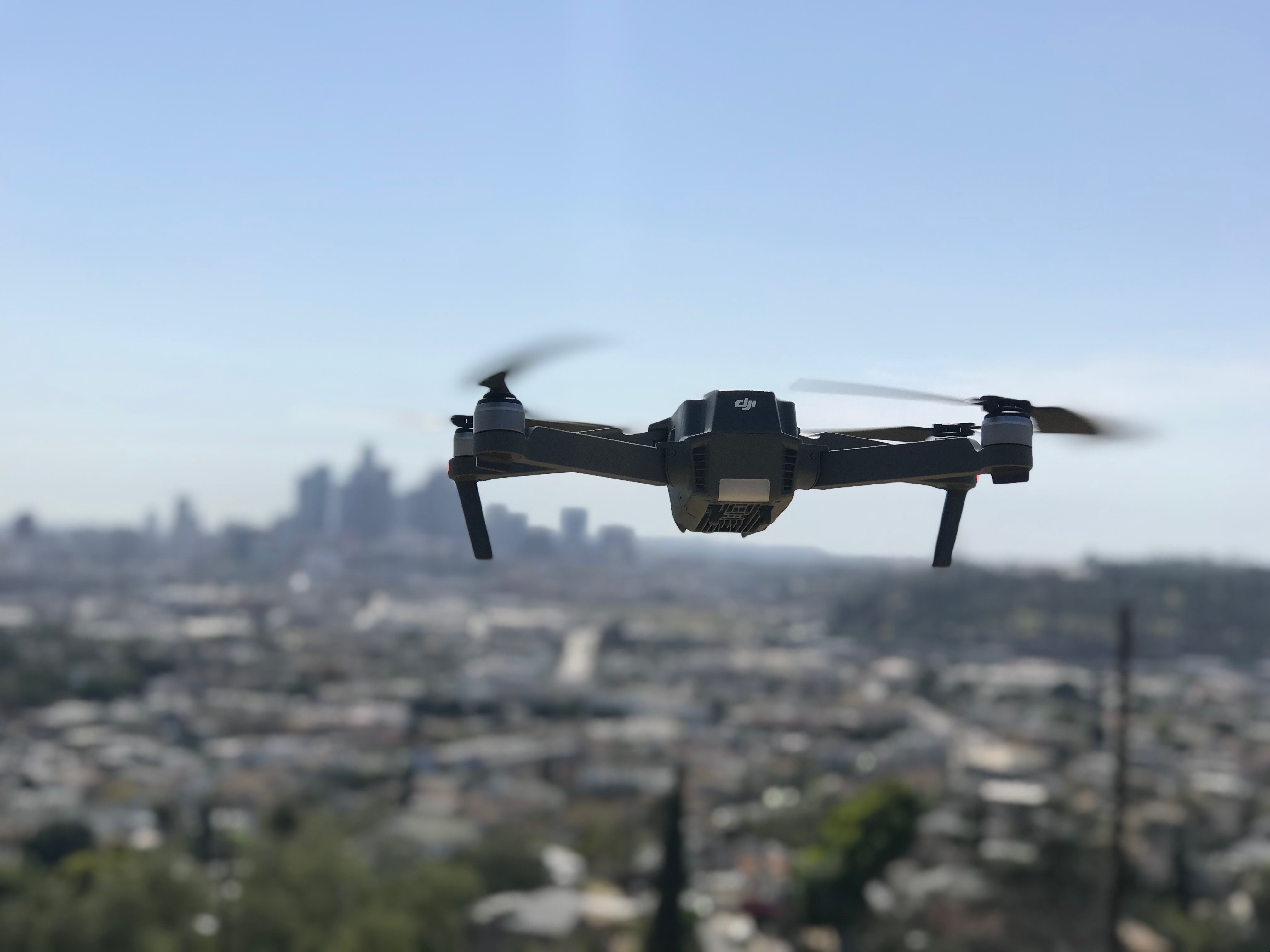
Drone in flight image courtesy of ShareGrid on Unsplash.
The facts are frightening. Gatwick, the second-busiest airport in the United Kingdom, was shut down for more than two days starting December 20, 2018. More than 120,000 passengers were affected and 1,000 flights cancelled or diverted just days before Christmas, all due to 92 confirmed drone sightings near the airport. The even-more-frightening facts? British police haven’t found the culprit yet and no one is sure if British military counter-drone equipment stopped the flights or if the culprit just quit.
As bad as this incident was, it could have been much worse. The perpetrator could have flown drones into the path of departing aircraft, hoping an airliner would ingest a drone and crash. An organized group could have shut down Gatwick, Heathrow, Stanstead, Manchester and Luton, leaving inbound transatlantic aircraft short on fuel with no place to divert. And as I have written about – repeatedly – explosive drones are widely used in the Middle East and easy to make.
Make no mistake: even if the Gatwick drone pilot or pilots turn out to be clueless remote pilot(s) versus a criminal one, this will happen again. There will be copycats. Some will do it for attention and some will do it with darker motives in mind. What once was a theoretical argument about the need for airport drone defenses is now a very real one, without much time to act.
[Editor’s Note: Since this column was written, more reports of rogue drones have been published, including this week’s incident at New Jersey’s Newark Liberty International Airport.]
The British Civil Aviation Authority (CAA) and American Federal Aviation Authority (FAA) are overwhelmed with drone-related regulatory and enforcement issues. Both agencies knew counter-UAS was an important topic but, given competing drone issues, neither devoted effort to counter UAS until two years ago. Despite increased attention, neither country has managed to transfer success in their military counter-drone policy and technology to defending their civilian airports.
Status Report
Where does the United States and United Kingdom stand in airport drone defense?
Authorities: Thankfully, both countries either have the authorities needed to defend their airports or soon will. Congress recently granted the FAA and DHS all the power they need to jam or destroy drones operating illegally near airports. The UK provided the needed counter-UAS authorities to the MoD during the Gatwick crisis. Even so, it became clear that the local Sussex Police lacked the expertise to address the situation, and this has the British government thinking of better ways to reinforce local jurisdictions. In February, Parliament will have its second reading of the “2019 Drone Bill” that grants counter-UAS authorities to British police. Hopefully, the Drone Bill will become law later this year.
Identification: Neither country has either the legal or technical means to remotely identify drones. I’ve addressed this subject repeatedly and won’t go over all the technical details again. Neither country has laws or policy permitting drone remote identification. Both countries need tamper-resistant, secure remote ID for drones that is integral to operation of the unmanned aerial vehicle (UAV) and supported by either law or policy. Remote ID should broadcast the tail number of the UAV, a unique code for the UAV operator, location of the operator and navigational data (heading, speed, altitude) for the UAV.
Currently, neither country has an effective drone registration process. Both countries should revamp their drone registration and require it at the point of sale, just as they do for automobiles. Neither country has drone detection devices deployed at its major airports. The U.S. has a handful of test airports with drone detection radars and the UK now has drone detection at Gatwick. Both countries must deploy detection devices (radar, electro-optical/infra-red cameras and signal geolocation antennas) around their key airports to track drones that don’t have remote ID.
Countermeasures: Neither country has a fool-proof method to down civilian drones unless the drones use GPS or are vulnerable to data link manipulation. Drones with autonomous flight software using GPS-denied navigation (scene matching, inertial navigation or simple dead reckoning) remain difficult to bring down. The British and American military have a variety of other methods, including net rockets/shells, lasers, gunfire and trained birds of prey, but none of these methods have been tried at a civilian airport before.
Retaking the Skies
How can we improve our airport drone defenses? In this case, BREXIT may help both Allies. Don’t get me wrong; I am not a BREXIT fan. However, once the UK is again free to set its own standards and laws, the impetus provided by Gatwick might get the UK moving faster than the U.S. on drone remote ID and defenses. When properly motivated, the British Parliamentary system can move much more quickly than America’s divided political system, particularly on technical subjects like remote ID and drone defense.
Other assets can come into play. The Royal Air Force has as much drone experience as the U.S. Air Force and its experience will be key in developing drone air space and remote ID procedures rapidly. The British Army’s hard-earned recent experience in dealing with the small drone threat overseas will come in handy when evaluating drone countermeasures. The FAA and British CAA have long-standing research agreements that will allow them to cooperatively research technology. Most importantly, the UK has traditionally been a bridge between Canadian-American airspace procedures and European. Hence, the UK taking the lead for remote ID and counter-UAS technology may lead to faster adoption on both continents.
Regardless of which country moves first, the threat of copycat interference with major airports means both countries must act – now. At an absolute minimum, they must deploy drone detection and data link countermeasures systems at all major airports. The British government deployed a military system to Gatwick and they should do the same for other airports until civilian counter-UAS systems are in place. Protecting American airports is a great mission for the National Guard and they, too, should remain in place until FAA counter-UAS systems are operational. Granted, data link countermeasure systems will only work against off-the-shelf drones and won’t work against autonomous or custom-made vehicles. However, data link countermeasures can easily force a consumer drone to either land or return home, making direct countermeasures like nets or guns unnecessary.
Stopping autonomous drones at a civilian airport is an unsolved problem. Military systems can use lasers, guns, missiles and even high-powered microwave weapons to bring down drones because they are willing to take risks to down them. These systems won’t work at a civilian airport with dozens of airliners with hundreds if not thousands of passengers. There have been experiments with nets, either launched by rockets, fired in special shotgun shells or deployed from interceptor drones. However, it would be difficult for ground-launched nets to reach a drone operating at more than a few hundred feet altitude. Interceptor drones might work better, but their technology is in its infancy. Dutch police, the U.S. Air Force Academy and Emirati Air Force have used specially trained birds of prey to take down drones, but they require extensive, lengthy training to employ.
I don’t know what the solutions will be in defending our airports, but I do know we need to aggressively pursue this problem like we did with airport ground security after 9/11. There will be more attacks and it IS that big of a threat. Airport screening was a manual affair in the months after 9/11, but the technology employed today is extremely advanced. We need a similar surge in technology, but we won’t get there if the FAA and UK CAA don’t have the same sense of urgency they had after 9/11.


